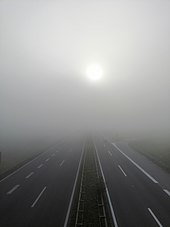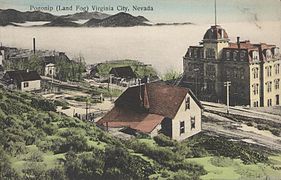Fog

| Part of a series on |
| Weather |
|---|
|
|
Fog is a visible
Fog appears when water vapor (water in its gaseous form) condenses. During condensation, molecules of water vapor combine to make tiny water droplets that hang in the air. Sea fog, which shows up near bodies of saline water, is formed as water vapor condenses on bits of salt. Fog is similar to, but less transparent than, mist.
Definition
The term fog is typically distinguished from the more generic term cloud in that fog is low-lying, and the moisture in the fog is often generated locally (such as from a nearby body of water, like a lake or the ocean, or from nearby moist ground or marshes).[3]
By definition, fog reduces visibility to less than 1 km (0.62 mi), whereas mist causes lesser impairment of visibility.[4]
For aviation purposes in the
]Formation

Fog forms when the difference between air temperature and dew point is less than 2.5 °C (4.5 °F).[6][7]
Fog begins to form when water vapor condenses into tiny water droplets that are suspended in the air. Some examples of ways that water vapor is condensed include wind convergence into areas of upward motion;[8] precipitation or virga falling from above;[9] daytime heating evaporating water from the surface of oceans, water bodies, or wet land;[10] transpiration from plants;[11] cool or dry air moving over warmer water;[12] and lifting air over mountains.[13] Water vapor normally begins to condense on condensation nuclei such as dust, ice, and salt in order to form clouds.[14][15] Fog, like its elevated cousin stratus, is a stable cloud deck which tends to form when a cool, stable air mass is trapped underneath a warm air mass.[16]
Fog normally occurs at a
Fog commonly produces
The thickness of a fog layer is largely determined by the altitude of the inversion boundary, which in coastal or oceanic locales is also the top of the marine layer, above which the air mass is warmer and drier. The inversion boundary varies its altitude primarily in response to the weight of the air above it, which is measured in terms of atmospheric pressure. The marine layer, and any fog-bank it may contain, will be "squashed" when the pressure is high, and conversely, may expand upwards when the pressure above it is lowering.
Types
Fog can form in a number of ways, depending on how the cooling that caused the condensation occurred.
Radiation fog is formed by the cooling of land after sunset by infrared thermal radiation in calm conditions with a clear sky. The cooling ground then cools adjacent air by conduction, causing the air temperature to fall and reach the dew point, forming fog. In perfect calm, the fog layer can be less than a meter thick, but turbulence can promote a thicker layer. Radiation fog occurs at night, and usually does not last long after sunrise, but it can persist all day in the winter months, especially in areas bounded by high ground. Radiation fog is most common in autumn and early winter. Examples of this phenomenon include tule fog.[19]
Ground fog is fog that obscures less than 60% of the sky and does not extend to the base of any overhead clouds.[20] However, the term is usually a synonym for shallow radiation fog; in some cases the depth of the fog is on the order of tens of centimetres over certain kinds of terrain with the absence of wind.

Advection fog occurs when moist air passes over a cool surface by advection (wind) and is cooled.[21] It is common as a warm front passes over an area with significant snow-pack. It is most common at sea when moist air encounters cooler waters, including areas of cold water upwelling, such as along the California coast (see San Francisco fog). A strong enough temperature difference over water or bare ground can also cause advection fog.
Although strong winds often mix the air and can disperse, fragment, or prevent many kinds of fog, markedly warmer and humid air blowing over a snowpack can continue to generate advection fog at elevated velocities up to 80 km/h (50 mph) or more – this fog will be in a turbulent, rapidly moving, and comparatively shallow layer, observed as a few centimetres/inches in depth over flat farm fields, flat urban terrain and the like, and/or form more complex forms where the terrain is different such as rotating areas in the lee of hills or large buildings and so on.
Fog formed by advection along the California coastline is propelled onto land by one of several processes. A cold front can push the marine layer coast-ward, an occurrence most typical in the spring or late fall. During the summer months, a low-pressure trough produced by intense heating inland creates a strong pressure gradient, drawing in the dense marine layer. Also, during the summer, strong high pressure aloft over the desert southwest, usually in connection with the summer
Evaporation fog or steam fog forms over bodies of water overlain by much colder air; this situation can also lead to the formation of
Frontal fog forms in much the same way as stratus cloud near a front when raindrops, falling from relatively warm air above a frontal surface, evaporate into cooler air close to the Earth's surface and cause it to become saturated. This type of fog can be the result of a very low frontal stratus cloud subsiding to surface level in the absence of any lifting agent after the front passes.
Ice fog forms in very low temperatures and can be the result of other mechanisms mentioned here, as well as the exhalation of moist warm air by herds of animals. It can be associated with the diamond dust form of precipitation, in which very small crystals of ice form and slowly fall. This often occurs during blue sky conditions, which can cause many types of halos and other results of refraction of sunlight by the airborne crystals.
Freezing fog, which deposits
Precipitation fog (or frontal fog) forms as
Hail fog sometimes occurs in the vicinity of significant hail accumulations due to decreased temperature and increased moisture leading to saturation in a very shallow layer near the surface. It most often occurs when there is a warm, humid layer atop the hail and when wind is light. This ground fog tends to be localized but can be extremely dense and abrupt. It may form shortly after the hail falls; when the hail has had time to cool the air and as it absorbs heat when melting and evaporating.[24]
Upslope fog forms when moist air is going up the slope of a mountain or hill (orographic lifting) which condenses into fog on account of
Freezing conditions
Freezing fog occurs when liquid fog droplets freeze to surfaces, forming white
In the western United States, freezing fog may be referred to as pogonip.[26] It occurs commonly during cold winter spells, usually in deep mountain valleys.
The word pogonip is derived from the Shoshone word paγi̵nappi̵h, which means "cloud".[26][27]
In
The phenomenon is also extremely common in the inland areas of the Pacific Northwest, with temperatures in the 10 to 30 °F (−12 to −1 °C) range. The Columbia Plateau experiences this phenomenon most years due to
Frozen fog (also known as
-
Pogonip fog in Virginia City, Nevada, from an early 20th-century postcard
-
A tree in a field during extreme cold with frozen fog
Topographical influences
Up-slope fog or hill fog forms when winds blow air up a
Valley fog forms in mountain valleys, often during winter. It is essentially a radiation fog confined by local topography, and can last for several days in calm conditions. In California's Central Valley, valley fog is often referred to as tule fog.

Sea and coastal fog
Sea fog (also known as haar or fret) is heavily influenced by the presence of sea spray and microscopic airborne salt crystals. Clouds of all types require minute hygroscopic particles upon which water vapor can condense. Over the ocean surface, the most common particles are salt from salt spray produced by breaking waves. Except in areas of storminess, the most common areas of breaking waves are located near coastlines, hence the greatest densities of airborne salt particles are there.
Condensation on salt particles has been observed to occur at humidities as low as 70%, thus fog can occur even in relatively dry air in suitable locations such as the California coast. Typically, such lower humidity fog is preceded by a transparent mistiness along the coastline as condensation competes with evaporation, a phenomenon that is typically noticeable by beachgoers in the afternoon. Another recently discovered source of condensation nuclei for coastal fog is kelp seaweed. Researchers have found that under stress (intense sunlight, strong evaporation, etc.), kelp releases particles of iodine which in turn become nuclei for condensation of water vapor, causing fog that diffuses direct sunlight.[29]
Arctic sea smoke is similar to sea smoke, but occurs when the air is very cold. Instead of condensing into water droplets, columns of freezing, rising, and condensing water vapor is formed. The water vapor produces the sea smoke fog, and is usually misty and smoke-like.[30]
-
Fog rolls into Seattle from the sea
-
Sea fog or "fret" encroaching onBrighton Pier
-
Sea fog in the Arctic Ocean near the island of Jan Mayen
Visibility effects


Depending on the concentration of the droplets, visibility in fog can range from the appearance of haze, to almost zero visibility. Many lives are lost each year worldwide from accidents involving fog conditions on the highways, including multiple-vehicle collisions.
The aviation travel industry is affected by the severity of fog conditions. Even though modern
A solution for landing returning military aircraft developed in World War II was called Fog Investigation and Dispersal Operation (FIDO). It involved burning enormous amounts of fuel alongside runways to evaporate fog, allowing returning fighter and bomber pilots sufficient visual cues to safely land their aircraft. The high energy demands of this method discourage its use for routine operations.
Shadows

Shadows are cast through fog in three dimensions. The fog is dense enough to be illuminated by light that passes through gaps in a structure or tree, but thin enough to let a large quantity of that light pass through to illuminate points further on. As a result, object shadows appear as "beams" oriented in a direction parallel to the light source. These voluminous shadows are created the same way as crepuscular rays, which are the shadows of clouds. In fog, it is solid objects that cast shadows.
Sound propagation and acoustic effects
Sound typically travels fastest and farthest through solids, then liquids, then gases such as the atmosphere. Sound is affected during fog conditions due to the small distances between water droplets, and air temperature differences.
Molecular effect: Though fog is essentially liquid water, the many droplets are separated by small air gaps. High-pitched sounds have a high frequency, which in turn means they have a short wavelength. To transmit a high frequency wave, air must move back and forth very quickly. Short-wavelength high-pitched sound waves are reflected and refracted by many separated water droplets, partially cancelling and dissipating their energy (a process called "
Temperature effect: A fog can be caused by a
Record extremes
Particularly foggy places include[
As a water source
Artificial fog

Artificial fog is man-made fog that is usually created by vaporizing a water- and
Historical references
The presence of fog has often played a key role in historical events, such as strategic battles. One example is the
See also
Technology
- Anti-fog
- Automotive lighting
- Decontamination foam
- Fog Investigation and Dispersal Operation (FIDO)
- Fog collection
- Foghorn
- Fog machine
- Fogging (photography)
- Fog lamp
- Head-up display
- Runway visual range
- Transmissometer
Weather
- Cloud
- Fog season
- Haboob (sandstorm)
- Mist
- San Francisco fog
- Smoke
- Smog
- Whiteout (weather)
- Vog
- Stratus
References
- ISBN 978-3-7643-8418-0. Archived from the original on 3 September 2016.)
The international definition of fog consists of a suspended collection of water droplets or ice crystal near the Earth's surface...
Reprint from Pure and Applied Geophysics. 164 (6–7). 2007.{{cite journal}}: CS1 maint: untitled periodical (link - ^ "What's the Difference Between Fog and Clouds?". NOAA. 2022.
- ISBN 0-7844-0795-9. Archived from the originalon 3 September 2016. Retrieved 27 March 2016.) In fact, some people commonly mistake mist for fog. These two are a little bit different as mist is thinner than fog. () Further distinguishing the terms, fog rarely results in rain, while clouds are the common source of rain.
- ^ "Federal Meteorological Handbook Number 1: Chapter 8 – Present Weather" (PDF). Office of the Federal Coordinator for Meteorology. 1 September 2005. pp. 8–1, 8–2. Archived from the original (PDF) on 21 May 2011. Retrieved 9 October 2010.
- ^ Annex 3 (17th ed.), July 2010
- ^ "Fog – AMS Glossary". Archived from the original on 27 March 2013. Retrieved 16 March 2013.
- ^ "Fog" (PDF). National Weather Service. 2022.
- ISBN 978-0-12-548035-2. Retrieved 2 January 2009.
- ^ "Virga and Dry Thunderstorms". National Weather Service Office, Spokane, Washington. Archived from the original on 22 May 2009.
- ^ Bart van den Hurk; Eleanor Blyth (2008). "Global maps of Local Land-Atmosphere coupling" (PDF). KNMI. Archived from the original (PDF) on 25 February 2009. Retrieved 2 January 2009.
- National Aeronautics and Space Administration Goddard Space Flight Center. Archived from the originalon 3 June 2008. Retrieved 2 January 2009.
- ^ National Weather Service JetStream (2008). "Air Masses". Archived from the original on 24 December 2008. Retrieved 2 January 2009.
- ^ Michael Pidwirny (2008). "CHAPTER 8: Introduction to the Hydrosphere (e). Cloud Formation Processes". Physical Geography. Archived from the original on 20 December 2008. Retrieved 1 January 2009.
- ^ "Front". Glossary of Meteorology. American Meteorological Society. 25 April 2012. Archived from the original on 10 October 2018.
- Hydrometeorological Prediction Center. Archived(PDF) from the original on 29 September 2006. Retrieved 9 October 2010.
- ^ FMI (2007). "Fog And Stratus – Meteorological Physical Background". Zentralanstalt für Meteorologie und Geodynamik. Archived from the original on 6 July 2011. Retrieved 7 February 2009.
- ^ ISBN 0849328454.
- ISBN 0292719639.
- ^ Cox, Robert E. Applying Fog Forecasting Techniques using AWIPS and the Internet Archived 29 October 2007 at the Wayback Machine. National Weather Service, 2007. nwas.org
- U.S. Department of Energy. education.arm.gov
- ISBN 978-0-7368-2093-6.
- ^ "Fog Facts". Fast Facts for Kids. 2022.
- ^ "NWS Glossary". National Weather Service. 2022.
- ^ Marshall, T., Hoadley, D. (1995). Storm Talk. Tim Marshall.[full citation needed]
- ^ a b Understanding Weather – Fog Archived 31 January 2009 at the Wayback Machine. BBC Weather. bbc.co.uk
- ^ a b "pogonip". Merriam-Webster.com Dictionary.
- ^ "Pogonip – Definition from the Dictionary.com". Archived from the original on 22 February 2014. Retrieved 2 January 2013.
- ^ Haby, Jeff. What is the difference between ice fog and freezing fog? Archived 8 January 2006 at the Wayback Machine theweatherprediction.com
- ^ Stressed seaweed contributes to cloudy coastal skies, study suggests Archived 11 May 2008 at the Wayback Machine, eurekalert.org
- ^ "Arctic Sea Smoke". encyclopedia.com. Archived from the original on 6 May 2016.
- ISBN 0521548012.
- ^ "Does fog have a dampening effect on sounds?". thenakedscientists.com. 14 June 2009. Archived from the original on 16 January 2015.
- ^ "How fog can play tricks on your ears?". katu.com. Archived from the original on 12 April 2015.
- ^ Joyce, Christopher (23 February 2010). "Fog Fluctuations Could Threaten Giant Redwoods". NPR. Archived from the original on 27 January 2016.
- ISBN 0124001513.
- Bibcode:2007PhDT........70T.
Under "[ ^ "Federal Meteorological Handbook Number 1: Chapter 8 – Present Weather" (PDF). Office of the Federal Coordinator for Meteorology. 1 September 2005. pp. 8–1, 8–2. Retrieved 9 October 2010. ] " ….
Actually use the following link- http://www.ofcm.gov/publications/fmh/FMH1/FMH1.pdf and proceed to Chapter 8, etc.
Further reading
- Ahrens, C. (1991). Meteorology today: an introduction to weather, climate, and the environment. West Pub. Co. ISBN 978-0-314-80905-6.
- Corton, Christine L. London Fog: The Biography (2015)
- Riddle, Laurence G.; Cayan, Daniel R.; Filonczuk, Maria K. (1 July 1995). "Variability of Marine Fog Along the California Coast".
{{cite journal}}: Cite journal requires|journal=(help) - Lu, Chunsong; Liu, Yangang; Niu, Shengjie; Zhao, Lijuan; Yu, Huaying; Cheng, Muning (30 January 2014). "Examination of microphysical relationships and corresponding microphysical processes in warm fogs". Acta Meteorologica Sinica. 27 (6): 832–848. S2CID 2471958.
- Lu, Chunsong; Niu, Shengjie; Tang, Lili; Lv, Jingjing; Zhao, Lijuan; Zhu, Bin (July 2010). "Chemical composition of fog water in Nanjing area of China and its related fog microphysics". Atmospheric Research. 97 (1–2): 47–69. .
External links
- Social & Economic Costs of Fog from "NOAA Socioeconomics" website initiative
- United States' current dense fog advisories from NOAA
- Current Western US fog satellite pictures from NOAA








